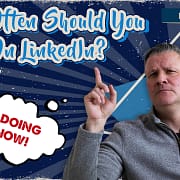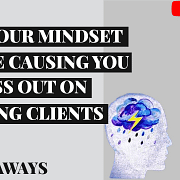How often should you post on LinkedIn to help you drive more new business?
We’re going to discuss that through the lens of a LinkedIn challenge, that I, for some reason, took part in.
All right, we’re all aware at this point that LinkedIn can be a really powerful tool for you and your advertising agency in terms of prospecting for new business.
I would never profess to be a LinkedIn expert, however, the reason you’re going to want to watch this video is twofold: one, I’ve had prospecting success bringing ad agencies on board at RSW, specifically through posted content on LinkedIn, so I can speak from that standpoint, but more interestingly, I recently took part in a LinkedIn challenge.
And I’ve got some knowledge to help you specifically think about how often you should post on LinkedIn.
Let’s set the stage and jump right into your first takeaway:
It’s generally recommended that you post once a day to be effective on LinkedIn.
If you Google a version of the phrase “how often to post on LinkedIn”, as you might imagine you will go down a freaking rabbit hole.
Anywhere from once a month to 5 times a day.
But generally, what you will glean from reading many, many posts, is that once a day is what you should shoot for.
In a post on social media frequency, Hootsuite said this:
LinkedIn itself has seen brands that post once a month gain followers six times faster than those who keep a lower profile. That pattern continues with more frequent posting: companies that post weekly see twice the engagement, while brands that post daily gain even more traction.
So I mentioned a challenge.
Jason Ellinger is the co-founder of Beard and Bowler, a full-service commercial filmmaking company in New Jersey, and he mentioned in a post he had spoken with a LinkedIn influencer who said if you really want to be effective on LinkedIn, you should post six times a day.
So I responded, commenting that seemed like a lot for LinkedIn. And Jason responded, hey, why don’t we throw out a challenge, and do that for a week, see what it gets us.
He suggested two or three posts a day. And then, Dan Enrico, director of strategy at DSM, a full-service agency in Jersey as well, comments back, let’s do six a day (I think that was Dan) and then Darren Magarro, who is the founder of DSM jumps in, so the four of us decide alright-one week, six posts a day on LinkedIn, see where that gets us.
Well, I had it in my head we were just doing a business week, so for that 5 day stretch I did post 6 times a day.
And apart from one personal post, it was all business development driven, for ad agencies.
How did posting on LinkedIn six times a day work out?
My profile views went down.
Yep.
Having said that, the views on my articles and posts did go up, in some cases substantially.
But again, hard to attribute that to the extra posts per day, because the week before, I started a LinkedIn newsletter.
That gave me a boost in the two and three hundreds of views on my articles. So after it’s said and done, I’ll give you your second takeaway:
Ignore the experts
I’m not saying all the time. There’s a reason they’re called experts, and if 6 times a day or more is working for that influencer, or anyone, more power to them.
However, I can tell you from my own experience, six posts a day didn’t get me any more views, comments or likes than when I posted twice a day, and in fact maybe hurt me more than it helped that week, at least in terms of profile views.
Unless you are a LinkedIn influencer, it’s going to be very difficult, even with the bank of content we have at RSW, to post six times a day and get your work done.
What I ultimately learned, and it’s your third takeaway:
The number of posts per day on LinkedIn matters less than the quality of what you post
Now, I’m glad I joined in on this challenge though, as it’s had a long tail.
Two and three weeks after, I’m still getting views, likes and comments on posts during the challenge.
So, it’s like your agency new business strategy, and something I talk about a lot.
You have to take baby steps.
Start with what you can initially manage, but you have to start. And then increase your activity as you get into a rhythm.
Alright, thanks to Jason, Dan and Darren, you can and you should follow them on LinkedIn, if you’re looking for some examples of what to post, and they’re just good people all around.
Thanks for watching 3 Takeaways-lots of new business content our site at rswus.com, just hit the resources dropdown.











